Broadway's Tangled Web
Broadway’s beleaguered new musical Spider-Man – with its much-ballyhooed spectacle, record-breaking $65-million price tag, 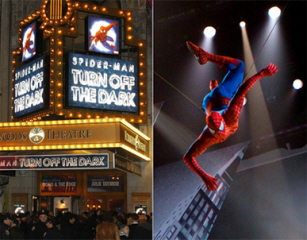 and four dramatic injuries to major cast members within four weeks – may turn out to be the best thing to hit the Great White Way in decades. Oh, artistically this brainchild of U2’s Bono, the Edge, and director Julie Taymor may crash and burn once bono fide theater critics are finally invited to see what all the hoopla is about. For now, however, Spider-Man: Turn off the Dark is attracting sell-out preview audiences and putting Broadway in a spotlight that even the best publicists and marketing pros couldn’t have manufactured.
and four dramatic injuries to major cast members within four weeks – may turn out to be the best thing to hit the Great White Way in decades. Oh, artistically this brainchild of U2’s Bono, the Edge, and director Julie Taymor may crash and burn once bono fide theater critics are finally invited to see what all the hoopla is about. For now, however, Spider-Man: Turn off the Dark is attracting sell-out preview audiences and putting Broadway in a spotlight that even the best publicists and marketing pros couldn’t have manufactured.
Bad press – if there really is such a thing – has been swirling around Spider-Man for months. First, producers couldn’t raise enough capital to make the show fly, so the original opening, set for February 2010, was delayed indefinitely. This resulted in the loss of two key Hollywood cast members: Alan Cumming as the Green Goblin and Evan Rachel Wood as Mary Jane Watson.
Then rock impresario Michael Cohl stepped in as lead producer and tapped music industry pals for funds. Extensive renovations to the 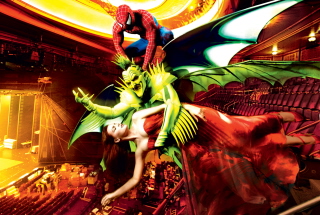 Foxwoods Theatre – needed to accommodate the never-before-seen flying sequences planned by Taymor – were completed, and new (lesser known) Broadway actors were cast in the roles vacated by the high-profile stars. A new opening was set for the fall of 2010 and it looked like Spider-Man would actually take flight.
Foxwoods Theatre – needed to accommodate the never-before-seen flying sequences planned by Taymor – were completed, and new (lesser known) Broadway actors were cast in the roles vacated by the high-profile stars. A new opening was set for the fall of 2010 and it looked like Spider-Man would actually take flight.
Unfortunately, ongoing technical problems postponed the opening two more times. Costs continued to climb, and then two Spider-Man stunt doubles were injured while demonstrating dramatic flying maneuvers. One crashed into a wall, breaking both wrists. The other landed too hard and fast on the floor, breaking both feet.
Despite these setbacks, Taymor and company appeared on 60 Minutes and proclaimed confidently that there is no art without risk. The show finally began previews on November 28, but that very night lead actress Natalie Mendoza, starring as spider villainess Arachne, suffered a concussion when struck backstage by a rope holding a piece of heavy equipment. On December 30 she left the production citing the need to continue her recovery.
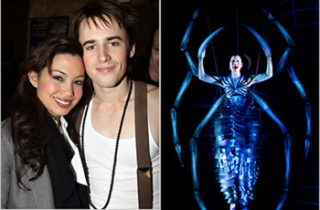 The most chilling blow to the show, however, came on December 20 when lead Spider-Man stunt double Christopher Tierney took an unplanned death-defying leap from an elevated set piece. As he jumped forward off the “bridge,” the cable securing him to the platform let go. Tierney fell almost 30 feet into the orchestra pit, sustaining a fractured skull, a broken scapula, four broken ribs, a bruised lung, three fractured vertebrae, a broken elbow, and internal bleeding. Had he not had the presence of mind to tuck and roll prior to hitting the floor, he would have landed on his head and probably have died.
The most chilling blow to the show, however, came on December 20 when lead Spider-Man stunt double Christopher Tierney took an unplanned death-defying leap from an elevated set piece. As he jumped forward off the “bridge,” the cable securing him to the platform let go. Tierney fell almost 30 feet into the orchestra pit, sustaining a fractured skull, a broken scapula, four broken ribs, a bruised lung, three fractured vertebrae, a broken elbow, and internal bleeding. Had he not had the presence of mind to tuck and roll prior to hitting the floor, he would have landed on his head and probably have died.
Since then Tierney has become the poster child for Spider-Man. He has undergone major back surgery and expects to make a full recovery. In interviews and television appearances, he cheerfully says he can’t wait to return to the show. 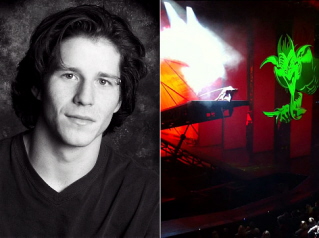 Once he is cleared from rehab, he wants to get back in his harness and again careen from rafter to rafter at upwards of 50 mph.
Once he is cleared from rehab, he wants to get back in his harness and again careen from rafter to rafter at upwards of 50 mph.
Maybe Tierney should be wearing a red cape and sporting a big bold S on his chest. He is unquestionably one super spokesperson.
As of this writing the official red carpet opening of Spider-Man: Turn off the Dark is set for February 7. (EDIT: Opening night has been postposed again till March 15.) Actor’s Equity Association, the Occupational Health and Safety Administration, and the New York State Department of Labor have all given the show the green light after demanding that stricter safety measures be put in place. Since the show reopened on December 22, no further accidents have been reported.
So how, exactly, is all this arachnophobia good for Broadway?
Quite simply, the harsh glare that has been shining on Spider-Man has finally illuminated problems that have been plaguing the industry for years.
- Theater actors, especially dancers, have a much higher job-related injury rate than most people in other fields. Stage fights, pratfalls, special effects, and repetitive stress all put actors at greater risk than the average Joe. Perhaps the collective outrage that has been expressed within the Broadway community over the excessive dangers inherent in this production will translate into more vigilant protocols and fail safe systems being implemented for all shows.
- For years now producers have been charging full price for preview performances despite the fact that shows in previews are still works-in-progress. Performances are commonly stopped to work out technical glitches, and what’s seen in previews is often a pale imitation of what is seen on the official opening night. Theater regulars know and understand this process and buy tickets accordingly. However, roughly 65% of all Broadway audiences are made up of tourists. They may not necessarily know when they are buying tickets to a preview. Therefore, prompted by Spider-Man’s repeated delays, exorbitant budget, high profile, and extensive problems, public advocates are now suggesting that any show’s advertising should be very clear about the nature of the show that people are buying. After all, if producers consider a show unfit for theater critics to review before it is frozen, then it is only fair that preview ticket buyers be advised that they may not be seeing a finished product.
- According to numerous theater fans who have been posting on blogs, message boards, and social networks, all the special effects in the world aren’t going to save Spider-Man: Turn off the Dark from being a huge artistic disappointment. Reports consistently suggest that its book, lyrics and score are dark, dull, and incomprehensible. One friend who saw the show recently called it unsalvageable.
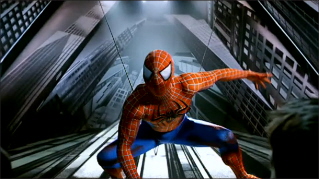 Given the immensely complicated sets, costumes, flying sequences, and special effects, the show is reportedly an unruly behemoth that would require months of reworking – and millions of additional dollars – to make good on its lofty promise. At this late date, can changes that would make the story more coherent and the music more engaging realistically be incorporated? Given the massively technical nature of the show, probably not. Of course, despite its problems, the spectacle that is Spider-Man may continue to attract sell-out audiences. Only time will tell if the sporadic thrills induced by the thought of an accident waiting to happen are enough to keep people satisfied. But wouldn’t it be grand if the Spider-Man saga ended up encouraging Broadway movers and shakers to return their creative focus first and foremost to telling really good stories? Production values should visually interpret and enhance the material, not overwhelm it. Perhaps the lesson to be learned here is that less really can be more.
Given the immensely complicated sets, costumes, flying sequences, and special effects, the show is reportedly an unruly behemoth that would require months of reworking – and millions of additional dollars – to make good on its lofty promise. At this late date, can changes that would make the story more coherent and the music more engaging realistically be incorporated? Given the massively technical nature of the show, probably not. Of course, despite its problems, the spectacle that is Spider-Man may continue to attract sell-out audiences. Only time will tell if the sporadic thrills induced by the thought of an accident waiting to happen are enough to keep people satisfied. But wouldn’t it be grand if the Spider-Man saga ended up encouraging Broadway movers and shakers to return their creative focus first and foremost to telling really good stories? Production values should visually interpret and enhance the material, not overwhelm it. Perhaps the lesson to be learned here is that less really can be more.
As the original Spider-Man of comic book fame taught us: “With great power comes great responsibility.” Julie Taymor and company, are you listening?
 and four dramatic injuries to major cast members within four weeks – may turn out to be the best thing to hit the Great White Way in decades. Oh, artistically this brainchild of U2’s Bono, the Edge, and director Julie Taymor may crash and burn once bono fide theater critics are finally invited to see what all the hoopla is about. For now, however,
and four dramatic injuries to major cast members within four weeks – may turn out to be the best thing to hit the Great White Way in decades. Oh, artistically this brainchild of U2’s Bono, the Edge, and director Julie Taymor may crash and burn once bono fide theater critics are finally invited to see what all the hoopla is about. For now, however,  Foxwoods Theatre – needed to accommodate the never-before-seen flying sequences planned by Taymor – were completed, and new (lesser known) Broadway actors were cast in the roles vacated by the high-profile stars. A new opening was set for the fall of 2010 and it looked like Spider-Man would actually take flight.
Foxwoods Theatre – needed to accommodate the never-before-seen flying sequences planned by Taymor – were completed, and new (lesser known) Broadway actors were cast in the roles vacated by the high-profile stars. A new opening was set for the fall of 2010 and it looked like Spider-Man would actually take flight. The most chilling blow to the show, however, came on December 20 when lead Spider-Man stunt double
The most chilling blow to the show, however, came on December 20 when lead Spider-Man stunt double  Once he is cleared from rehab, he wants to get back in his harness and again careen from rafter to rafter at upwards of 50 mph.
Once he is cleared from rehab, he wants to get back in his harness and again careen from rafter to rafter at upwards of 50 mph. Given the immensely complicated sets, costumes, flying sequences, and special effects, the show is reportedly an unruly behemoth that would require months of reworking – and millions of additional dollars – to make good on its lofty promise. At this late date, can changes that would make the story more coherent and the music more engaging realistically be incorporated? Given the massively technical nature of the show, probably not. Of course, despite its problems, the spectacle that is Spider-Man may continue to attract sell-out audiences. Only time will tell if the sporadic thrills induced by the thought of an accident waiting to happen are enough to keep people satisfied. But wouldn’t it be grand if the Spider-Man saga ended up encouraging Broadway movers and shakers to return their creative focus first and foremost to telling really good stories? Production values should visually interpret and enhance the material, not overwhelm it. Perhaps the lesson to be learned here is that less really can be more.
Given the immensely complicated sets, costumes, flying sequences, and special effects, the show is reportedly an unruly behemoth that would require months of reworking – and millions of additional dollars – to make good on its lofty promise. At this late date, can changes that would make the story more coherent and the music more engaging realistically be incorporated? Given the massively technical nature of the show, probably not. Of course, despite its problems, the spectacle that is Spider-Man may continue to attract sell-out audiences. Only time will tell if the sporadic thrills induced by the thought of an accident waiting to happen are enough to keep people satisfied. But wouldn’t it be grand if the Spider-Man saga ended up encouraging Broadway movers and shakers to return their creative focus first and foremost to telling really good stories? Production values should visually interpret and enhance the material, not overwhelm it. Perhaps the lesson to be learned here is that less really can be more.